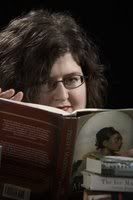 Clara Dunne was a celebrity before she truly understood what the words meant. The subject of her mother’s controversial photos, Clara’s childhood was consumed by art and her role as her mother’s muse. At eighteen she escaped and made a new life for herself, away from the glare of New York; now however, her mother’s illness is pulling her back into a world she’s spent a lifetime trying to forget.
Clara Dunne was a celebrity before she truly understood what the words meant. The subject of her mother’s controversial photos, Clara’s childhood was consumed by art and her role as her mother’s muse. At eighteen she escaped and made a new life for herself, away from the glare of New York; now however, her mother’s illness is pulling her back into a world she’s spent a lifetime trying to forget.In Black & White Dani Shapiro explores difficult territory - the issue of rights - for both artist and muse. She then makes the issue more complex by adding family dynamics to the mix, in this case the artist is also the mother of her subject. She raises a challenging question: “can a mother protect her child and still honour her muse when the subject of her best work is her child.”
The quick answer to this question appears to be no for when we first meet Clara she still bears the deep scars from being her mother’s muse. Clara’s raw, unfettered anguish roils off the page, causing the reader to gasp as the emotion hits like a ton of bricks. Her pain is so real that readers are cast adrift to share her gaping wounds.
Whose rights take precidence – the artist’s need to create or the child’s to own their life? Clara feels she is living a shadow life, that she never really owned her existence. “And so Clara wandered the campus at Yale University, surrounded by real people, as she thought of them, living real lives. She herself had forfeited that right – or perhaps she’d never had it at all…Was there a place in the world for someone like her?” Clara perceived herself as only existing when seen through her mother’s lens, perhaps an understandable reaction given that she dissociates from herself during photo shoots. The fact that Clara believes she's forfeited the right to a life is perhaps the most chilling statement made in this novel.
In Black & White there are no winners or losers. Shapiro does not take the easy way out, allowing readers to feel only sympathy for Clara. She insists that readers see all sides and manages her prose so deftly that within chapters readers are reluctantly driven to understand the urges that motivate Ruth. Within Ruth the artist continually wins out over the mother. She seems unable to refrain from capturing what her inner eye sees, even at the ultimate cost.
The ripple effects from Ruth’s decisions are far reaching. Clara and her sister Robin have carried their scars with them and the damage reaches their children as well. Robin was invisible to her mother and she has no emotional warmth for her own children. Clara has hidden her entire past from her daughter Sam, keeping her daughter away from Ruth and, by extension, an understanding of family history and Sam’s place in the world. The numbness in which she exists has kept her husband and child from feeling she is an active part of their family.
Within Black & White there are many competing claims of selfishness. Even though decisions are made to protect the individual, each character could make a valid claim that those decisions were made purely in another’s self interest. There are no black or white answers to the questions Shapiro raises, here there is only grey.
Shapiro only lightly touches on the most disturbing aspect of Ruth’s creativity, that the images of her naked child may be used by pedophiles. Given how far she already pushed her readers, she can be forgiven for not taking the last step and pushing them over the cliff.
ISBN10: 0375415483
ISBN13: 9780375415487
Hardcover
272 Pages
Publisher: Knopf
Publication Date: April 3, 2007
Author Website: www.danishapiro.com
tags: books book reviews Dani Shapiro family relationships mother daughter relationships


No comments:
Post a Comment